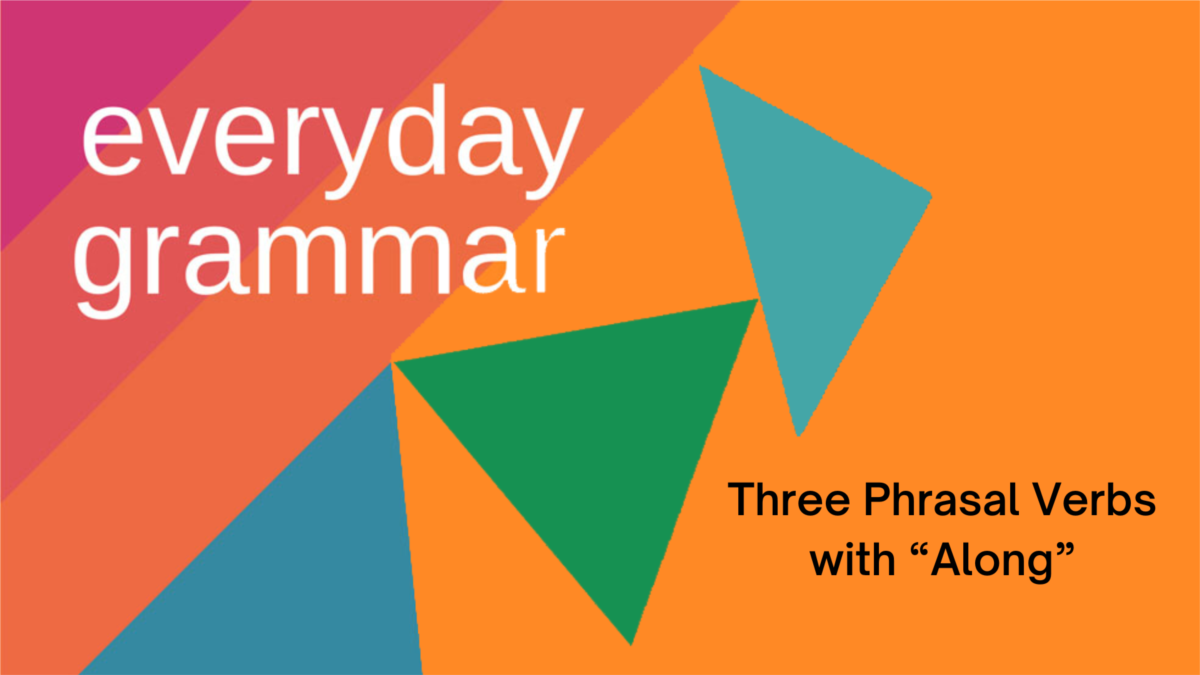"We drove along the coast of Maine".
We use “along” in this sentence to say that we drove on a road that runs next to, or near, the coast.
"We saw beautiful beach houses along the drive".
Here we use “along” to mean points. The beach houses are the points.
Along as an adverb has many meanings. We can use “along” to describe the forward movement of something. It can also mean to be “in the company of” or “in addition to.”
When we add “along” to a verb, we get these more exact meanings.
Phrasal verbs are groups of words made up of a verb and another short word or words. Together, these groups of words mean something different from what the individual words suggest. As a result, you can think of phrasal verbs as kinds of special expressions.
There are many phrasal verbs in English, and often each phrasal verb can have different meanings.
Let’s try to simplify Noura’s three phrasal verbs, “come along," “send along” and “tag along.”
“Come along” is our first phrasal verb. It means to go with or accompany someone. Usually that person is the one who leads the way. So, the person that is “coming along” is the secondary person, who is okay with someone leading them.
"Do you mind if I come along to the store with you? I just need a few things for dinner".
Come along is a phrasal verb with other meanings, too.
It can mean to make progress.
"Your painting is coming along nicely. It is almost done".
And lastly, “come along” means to make an appearance.
"Blue moons come along every two or three years, usually".
The next phrasal verb with “along” is “send along.” It has two meanings. The first meaning is to send something additional with something else.
"My sister mailed me a gift last week and sent along a letter from my parents".
In addition to the gift, the letter was also sent.
“Send along” also means to dismiss. Usually, we can separate this phrasal verb for this meaning.
The teacher sent the children along to lunch.
send somebody along to.
send somebody along toは直訳すると「誰かを何々に送る」という意味ですが、「誰かを特定の活動に向かわせる」「誰かに特定の活動をするように指示する」という意味になります。この場合のalongには「指示に従わせる」というニュアンスが含まれます。
Translation.
We drove along the coast of Maine.(私たちはメイン州の海岸沿いをドライブしました。)この文では、海岸沿いまたは海岸近くの道路をドライブしたという意味でalongを使用しています。We saw beautiful beach houses along the drive.(ドライブ中に美しいビーチハウスを見ました。)ここでは、ドライブをしている最中に、という意味でalong使用しています。 副詞としての along には多くの意味があります。alongは何かが前進する様子を表すために使用できます。また「何々と一緒にいる」または「何々に加えて」という意味にもなります。動詞にalongを追加すると、より正確な意味になります。句動詞は、動詞と別の短い単語または単語で構成される単語のグループです。これらの単語のグループを組み合わせると、個々の単語が示唆するものとは異なる意味になります。そのため、句動詞は一種の特別な表現と考えることができます。英語には多くの句動詞があり、句動詞ごとに異なる意味を持つことがよくあります。Nouraが言う3つの句動詞、come along, send along, tag alongを分かり易く説明してみましょう。最初の句動詞はcome alongです。come alongは「誰かと一緒に行く」「誰かと同行する」ことを意味します。主体となる誰かが存在していて、その誰かについて行く2次的な人がいた場合、その2次的な人の行動を表すのがcome alongです。Do you mind if I come along to the store with you? I just need a few things for dinner.(一緒にお店に行ってもいいですか? ちょっと夕食にいくつか必要なものがあるので。)come along は他の意味を持つ句動詞でもあります。come alongには「進歩する」という意味もあります。Your painting is coming along nicely. It is almost done.(あなたの絵は順調に仕上がっています。ほぼ完成していますね。)そして最後に、come alongには「姿を現す」という意味があります。Blue moons come along every two or three years, usually.(ブルームーンは通常、2~3年に1回やってきます。)alongを含む次の句動詞はsend alongです。これには 2つの意味があります。1つ目の意味は、何かと一緒に何か追加で送るということです。My sister mailed me a gift last week and sent along a letter from my parents.(先週、姉がプレゼントを郵送してくれて、両親からの手紙も一緒に送ってくれました。)In addition to the gift, the letter was also sent.(プレゼントに加えて、手紙も送られてきました。)send alongには、解散するという意味もあります。通常、この意味のためにこの句動詞を分けることができます。The teacher sent the children along to lunch.(先生は子供たちを解散させて昼食に向かわせました。)

